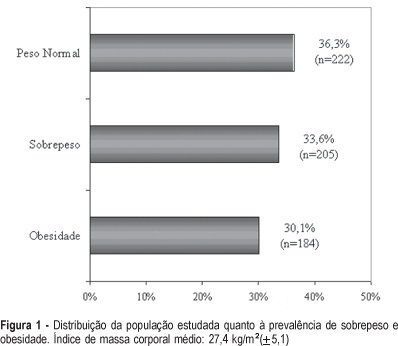You searched for:"Dino Roberto Soares De Lorenzi"
We found (6) results for your search.-
Editorial
Evaluation of quality of life in climacterium
Rev Bras Ginecol Obstet. 2008;30(3):103-106
Summary
-
Original Article
Prevalence of overweight and obesity among climacteric women
Rev Bras Ginecol Obstet. 2005;27(8):479-484
Summary
Original ArticlePrevalence of overweight and obesity among climacteric women
Rev Bras Ginecol Obstet. 2005;27(8):479-484
DOI 10.1590/S0100-72032005000800008
Views0See morePURPOSE: to evaluate the prevalence of overweight and obesity among climacteric women. METHODS: this cross-sectional study included 611 women aged between 45 and 60 years attended at a climacteric clinic from January to June 2003. The prevalence of overweight and obesity was evaluated through the body mass index (BMI). Overweight or obesity was considered when there was a BMI equal or higher than 25 kg/m². Sociodemographic and reproductive variables as well as life style were also evaluated. The chi2 test followed by logistic regression was performed for statistical analysis. RESULTS: the average age of the studied women was 51.4 (±4.4) years, whereas 52.9% of them were postmenopausal. About 63.7% of them had a BMI equal or higher than 25 kg/m². The prevalence of overweight and obesity was 33.6 and 30.1%, respectively. The prevalence of overweight and obesity was higher among older women (OR=1.2; 95%IC: 1.1-1.4) or non hormonal therapy users (OR=1.8; 95%IC: 1.2-2.8). The opposite was observed among the women without a professional occupation (OR=0.6; 95%IC: 0.5-0.9) or a steady partner (OR=0.7; 95%IC: 0,4-0,9). CONCLUSIONS: in this study, the prevalence of overweight and obesity was influenced by age, but not by the menopausal status. The association between the marital status and occupation and the BMI strengthens the hypothesis that the health of the climacteric women may be influenced by biological factors as well as by psychosocial factors and life style. The lowest prevalence of overweight and obesity among the users of hormonal therapy may be explained by possible restrictions in relation to its prescription for women with previous overweight or obesity. Further studies are necessary to get more conclusive results, in particular with longitudinal studies.

-
Original Article
Predicting factors of climacteric symptoms
Rev Bras Ginecol Obstet. 2005;27(1):7-11
Summary
Original ArticlePredicting factors of climacteric symptoms
Rev Bras Ginecol Obstet. 2005;27(1):7-11
DOI 10.1590/S0100-72032005000100004
Views1See morePURPOSE: to identify factors associated with climacteric symptoms. METHODS: a cross-sectional study of 254 women aged between 45 and 60 years was carried out at the Climacterium Outpatient Clinic of Caxias do Sul University, RS, from June to October 2002. Women with previous hysterectomy or under hormonal therapy were excluded. The climacteric symptoms were evaluated by means of the Kuppermann index and the attitudes toward menopause by a specific questionnaire. Data were analyzed by Student’s t test, analysis of variance (ANOVA) and multiple linear regression analysis. RESULTS: twenty eight percent of the women reported mild climacteric symtoms, whereas 42.3% reported moderate symptoms and 30.7%, intense symptoms. The most prevalent symptoms were: irritability (87.1%), arthralgias/myalgias (77.5%) and melancholy (73.2%), while the most severe were hot flushes in 60.2% of the women, irritability and insomnia. Attitudes toward menopause, skin color and physical activity were predictors of climacteric symptoms. Positive attitudes toward menopause (p=0.01), white color (p=0.02) and the habit of practicing physical activity (0.04) were associated with less intense climacteric symptoms. Negative attitudes toward menopause were associated with worse climacteric symptoms (p<0.01). CONCLUSIONS: in the current study, the climacteric symptoms were influenced by psychosocial factors and physical activity, as well as by climacteric hypoestrogenism.
-
Original Article
Congenital Syphilis as a Prenatal Care Marker
Rev Bras Ginecol Obstet. 2001;23(10):647-652
Summary
Original ArticleCongenital Syphilis as a Prenatal Care Marker
Rev Bras Ginecol Obstet. 2001;23(10):647-652
DOI 10.1590/S0100-72032001001000006
Views1See morePurpose: to study the prevalence of congenital syphilis in a universitary hospital of the south of Brazil, emphasizing its role as a prenatal care marker. Patients and Method: a descriptive study of the congenital syphilis cases which occurred at the Hospital Geral (HG-UCS) from June 1st, 2000 to May 31st, 2001, based on the diagnosis criteria proposed by the Center for Disease Control and Prevention (CDC, 1998). Results: The prevalence of congenital syphilis was 1.5 (27 cases in 1739 births). The coefficient of congenital syphilis observed was 15.5/1000 newborns. Twenty-three pregnant women (85.2%) received prenatal care; however, the maternal infection with syphilis was diagnosed before the delivery in only 16 (69.6%) cases. Only 4 pregnant women reported an appropriate prenatal treatment of syphilis. In 8 (29.6%) cases an association of maternal syphilis with other sexually transmissible diseases was observed. The coefficient of perinatal mortality was 1.15/1000 births (two perinatal deaths). Conclusions: The authors reaffirm the importance of congenital syphilis as an indicator of perinatal health, since it is a disease that may be completely prevented by prenatal care. In addition, a high prevalence of congenital syphilis allows one to question the quality of the prenatal care, which was available to the studied group.
-
Original Article
Risk Factors for Stillbirth at a Universitary Hospital in Southern Brazil
Rev Bras Ginecol Obstet. 2002;24(9):617-622
Summary
Original ArticleRisk Factors for Stillbirth at a Universitary Hospital in Southern Brazil
Rev Bras Ginecol Obstet. 2002;24(9):617-622
DOI 10.1590/S0100-72032002000900008
Views0See morePurpose: to study the influence of the prenatal care, fetal and maternal factors on the stillbirth rates of a university hospital from the south of Brazil. Methods :a case-control study of the cases of stillbirth occurred before the beginning of labor, from March 1998 to June 2001, at the Hospital Geral of Caxias do Sul University. The controls were selected among live newborns. The analysis of the quality of the prenatal care was based on the criteria established by the Programa de Humanização do Pré-natal e Nascimento of the Brazilian Health Ministry (2000). To evaluate possible risk factors for stillbirth we used the odds ratio (OR). Other confounding factors were evaluated by logistic regression. Results: preterm delivery was more prevalent in the cases of stillbirth (31.7+4.7 vs 38.6+0.9). The average birth weight among the stillborns was 1,705 g (+837 g), while in the controls it was 3,080 g (+576 g). Prenatal care was observed in 81.5% of the stillbirths and in 91.6% of the control group. The initial analysis showed that three factors were associated with stillbirth: inadequate prenatal care (43.6 vs 23.4%), history of previous stillbirth (6.6 vs 0.9%) and maternal age (27+7.9 years vs 24+6.4 years). Nevertheless, after adjustment of these variables through logistic regression, only the maternal age maintained its association with the stillbirth rates. Conclusions: in the present study, the strongest factor associated with the occurrence of stillbirth was the increase in maternal age.
-
Original Article
Pré-natal Care Profile among Public Health Service (“Sistema Único de Saúde”) Users from Caxias do Sul
Rev Bras Ginecol Obstet. 2002;24(5):293-299
Summary
Original ArticlePré-natal Care Profile among Public Health Service (“Sistema Único de Saúde”) Users from Caxias do Sul
Rev Bras Ginecol Obstet. 2002;24(5):293-299
DOI 10.1590/S0100-72032002000500002
Views4See morePurpose: to study the prenatal care among Public Health Service (“Sistema Único de Saúde”) users from Caxias do Sul – RS. Methods: a transversal study of 702 pregnancies attended at the Hospital Geral -Universidade de Caxias do Sul from March 2000 to March 2001 based on the criteria set by the “Programa Nacional de Humanização do Pré-natal e Nascimento (PNHPN)” of the Brazilian Ministry of Health. Results: the observed prenatal coverage was 95.4%, whereas the average of visits was 6.2. The main reported reason for not following prenatal care was the lack of information about its importance (65.6%). In 51.5% of the cases, prenatal care started in the third month of pregnancy, whereas 44.3% of the pregnant women carried out all the proposed complementary tests. Prenatal care was considered inappropriate in 64.8% and appropriate in 35.2% of the cases. The quality of prenatal attention was significantly associated with the mother’s education, as well as with the number of previous deliveries. The higher the educational level, the better the quality of observed prenatal care (p=0.0148). In addition, the higher number of previous deliveries showed to be associated with a later beginning of prenatal care and a lower number of visits (p=0.0008). Conclusions: the prenatal care available at Caxias do Sul in spite of its good coverage, should be reviewed in terms of quality. Special attention should be given to education in health along the prenatal assistance.
Search
Search in:
Tag Cloud
breast (42) breast cancer (42) breast neoplasms (95) Cesarean section (72) endometriosis (66) infertility (56) Maternal mortality (43) menopause (82) obesity (58) postpartum period (40) pregnancy (225) Pregnancy complications (99) Prenatal care (68) prenatal diagnosis (50) Prevalence (41) Quality of life (51) risk factors (94) ultrasonography (79) urinary incontinence (40) women's health (48)


